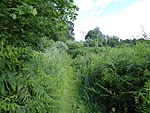Melton railway station, Suffolk
DfT Category F2 stationsFormer Great Eastern Railway stationsGreater Anglia franchise railway stationsPages with no open date in Infobox stationRailway stations in Great Britain closed in 1955 ... and 5 more
Railway stations in Great Britain opened in 1859Railway stations in Great Britain opened in 1984Railway stations in SuffolkReopened railway stations in Great BritainUse British English from December 2017

Melton railway station is on the East Suffolk Line in the east of England, serving the village of Melton, Suffolk. It is 11 miles 49 chains (18.7 km) down the line from Ipswich and 80 miles 28 chains (129.3 km) measured from London Liverpool Street; it is situated between Woodbridge and Wickham Market. Its three-letter station code is MES. The station was opened in 1859 but was closed in 1955 and remained so until 1984 when, after a local campaign, it was reopened. Today it is managed by Abellio Greater Anglia, which also operates all trains that call. It is 1.25 miles from the ancient Anglo-Saxon burial site at Sutton Hoo, run by the National Trust.
Excerpt from the Wikipedia article Melton railway station, Suffolk (License: CC BY-SA 3.0, Authors, Images).Melton railway station, Suffolk
Wilford Bridge Road, East Suffolk
Geographical coordinates (GPS) Address Nearby Places Show on map
Geographical coordinates (GPS)
| Latitude | Longitude |
|---|---|
| N 52.104 ° | E 1.338 ° |
Address
Wilford Bridge Road
IP12 1LT East Suffolk
England, United Kingdom
Open on Google Maps











